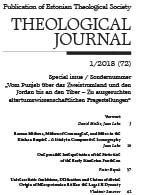Roman Mithras, Mithra of Commagene, and Miiro in the Kushan Empire – a Study in Comparative iconography
Roman Mithras, Mithra of Commagene, and Miiro in the Kushan Empire – a Study in Comparative iconography
Author(s): Jaan LaheSubject(s): Cultural history, Ancient World, Cultural Anthropology / Ethnology
Published by: Akadeemiline Teoloogia Selts
Keywords: god Mithra; Comparative iconography;
Summary/Abstract: Although the god Mithra, with its name variations, is known in different Indo- European religions, we have no basis to talk about a single Mithra religion that spread from Spain to Central Asia and India. The functions and traits characteristics of this god also vary in spatially close religions. However, there are amazing similarities coincidences in depicting the god in different religions. These are related to several iconographic details. It is known that the oldest images of Mithra (one fully recognisable sculpture and several reliefs) originate from the territory of the Kingdom of Commagene, located in Asia Minor, and have been dated to the 1st century BC. These depict Mithra wearing a tiara or a Phrygian cap, decorated with stars, and shaking hands with King Antiochus I. The god’s Persian-inspired attire (long trousers, coat thrown over the shoulders) resembles that of the king and the hand shake refers to friendship between the god and the king. The god’s head is surrounded by a halo which emphasises his solar nature, which is also emphasised by identifying him with Apollon in the inscriptions of Commagene. The Kushan Empire, which included large swaths of territory in Afghanistan, Turkmenistan, Tajikistan, Uzbekistan, Pakistan, and India, is separated from the Kingdom of Commagene by a relatively large area. However, images of Mithra have been found from the territory of Kushan (here called Miiro or Mirro), the iconographic details of which are surprisingly similar to those of the Mithra images found in the territory of the Kingdom of Commagene. The findings are gold coins from the reign of emperors Kanishka the Great and Huvishka, who ruled in the 1st and 2nd century BC. In addition, several reliefs from the same era have been found, depicting the king with different gods. The coins found in the Kushan Empire also depict Mithra with a cloak on his shoulders and wearing long trousers, his head surrounded with a halo. Some coins from the reign of Kanishka have the god’s name, Mithra, replaced with the Greek version, Helios. The Kushan reliefs depict the god Mithra shaking hands with the king, and his clothes resemble that of the king. The Mithra cult that spread in the Roman Empire included different ways of depicting the god, but is notable that several important iconographic details, which we are able to see in the Roman Empire, Kingdom of Commagene, and Kushan Empire, overlap. We cannot prove that the Roman Mithra cult was an imported cult from the Kingdom of Commagene or the Kushan Empire, but the overlapping of the listed iconographic details is hardly incidental. In both the Kingdom of Commagene and the Kushan Empire, the cultural spaces of Greece and Iran met. It was within this syncretic cultural space that the iconography developed, the elements of which can be seen in the iconography of the Mithra cult in the Roman Empire. Thus, the researchers of the iconography of the Mithra cult should also study the iconography of the cultures beyond the borders of the Roman Empire. However, one may ask whether and to what extent these have directly influenced the iconography of the Roman Mithra cult, but it is a fact that all the previously mentioned monuments originate, broadly speaking, from the same era and from areas that had close contact with each other.
Journal: Usuteaduslik Ajakiri
- Issue Year: 2018
- Issue No: 1 (72)
- Page Range: 16-36
- Page Count: 21
- Language: English

